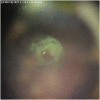Advanced cutting strategy for navigated, robot-driven laser craniotomy for stereoelectroencephalography: An in Vivo non-recovery animal study
- PMID: 36172304
- PMCID: PMC9510662
- DOI: 10.3389/frobt.2022.997413
Advanced cutting strategy for navigated, robot-driven laser craniotomy for stereoelectroencephalography: An in Vivo non-recovery animal study
Abstract
Objectives: In this study we aimed to present an updated cutting strategy and updated hardware for a new camera system that can increase cut-through detection using a cold ablation robot-guided laser osteotome. Methods: We performed a preoperative computed tomography scan of each animal. The laser was mounted on a robotic arm and guided by a navigation system based on a tracking camera. Surgery was performed with animals in the prone position. A new cutting strategy was implemented consisting of two circular paths involving inner (full cylindric) and outer (hollow cylindric) sections, with three different ablation phases. The depth electrodes were inserted after cut-through detection was confirmed on either the coaxial camera system or optical coherence tomography signal. Results: A total of 71 precision bone channels were cut in four pig specimens using a robot-guided laser. No signs of hemodynamic or respiratory irregularities were observed during anesthesia. All bone channels were created using the advanced cutting strategy. The new cutting strategy showed no irregularities in either cylindrical (parallel walled; n = 38, 45° = 10, 60° = 14, 90° = 14) or anticonical (walls widening by 2 degrees; n = 33, 45° = 11, 60° = 13, 90° = 9) bone channels. The entrance hole diameters ranged from 2.25-3.7 mm and the exit hole diameters ranged from 1.25 to 2.82 mm. Anchor bolts were successfully inserted in all bone channels. No unintended damage to the cortex was detected after laser guided craniotomy. Conclusion: The new cutting strategy showed promising results in more than 70 precision angulated cylindrical and anti-conical bone channels in this large, in vivo non-recovery animal study. Our findings indicate that the coaxial camera system is feasible for cut-through detection.
Keywords: SEEG; cutting strategy; depth electrodes; epilepsy surgery; navigated; robotic.
Copyright © 2022 Winter, Beer, Gono, Medagli, Morawska, Dorfer and Roessler.
Conflict of interest statement
DB, PG, SM, and MM were currently employed by Advanced Osteotomy Tools. The remaining authors declares that the research was conducted in the absence of any commercial or financial relationships that could be construed as a potential conflict of interest.
Figures







References
-
- Augello M., Baetscher C., Segesser M., Zeilhofer H. F., Cattin P., Juergens P. (2018). Performing partial mandibular resection, fibula free flap reconstruction and midfacial osteotomies with a cold ablation and robot-guided Er:YAG laser osteotome (CARLO) – a study on applicability and effectiveness in human cadavers. J. Cranio-Maxillofacial Surg. 46, 1850–1855. 10.1016/j.jcms.2018.08.001 - DOI - PubMed
-
- Baek K. W., Deibel W., Marinov D., Griessen M., Bruno A., Zeilhofer H. F., et al. (2015). Clinical applicability of robot-guided contact-free laser osteotomy in craniomaxillo-facial surgery: In-vitro simulation and in- vivo surgery in minipig mandibles. Br. J. Oral Maxillofac. Surg. 53, 976–981. 10.1016/j.bjoms.2015.07.019 - DOI - PubMed
LinkOut - more resources
Full Text Sources

